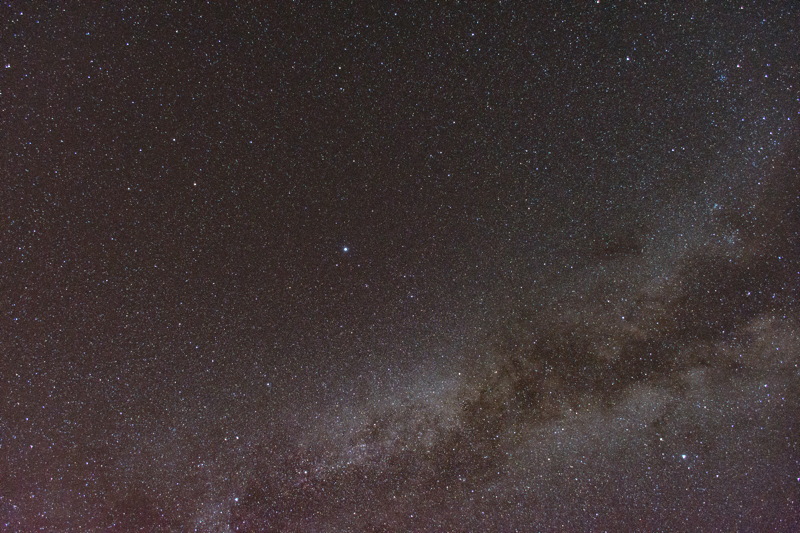iPhone NightCap Pro sky images,
LXD55 GEM tests, DSLR sky images
Posted: 3 July 2016
Thursday, 23 June 2016, began an extended period of mostly cloudy skies as our Monsoon Season kicked in. The 15,350 acre Brown Fire ~70 miles southwest of Cassiopeia Observatory was reported at 80% contained on Friday, 24 June. The smoke was no longer a factor here.
On Friday, 24 June, I set up the LXD55 GEM with the DSLR and 300mm lens to do a TRAIN DRIVES on a distant terrestrial object in anticipation of more tests with the LXD55 mount. While the 300mm lens didn't provide a lot of magnification for a precise TRAIN DRIVES it was probably adequate for the tests. Once I know that the mount and AutoStar will still GOTO objects as reliably as it did 10 years ago when I stopped using it with a telescope I will then defork the ETX-105 OTA (optical tube assembly) and check clearances on the LXD55 before ordering mounting rings.
Saturday, 25 June, was mostly cloudy. That evening I was at Oracle State Park for a star party. A report is on the Oracle Dark Skies Committee web site.
Overnight Tuesday-Wednesday, 28-29 June, received 0.4" rain from one storm, with lots of lightning. Overnight Wednesday-Thursday, 29-30 June, received 0.7" from another strong thunderstorm. The cloudy sky after sunrise on Thursday prevented imaging a transit of the crescent Moon by the International Space Station (ISS).
Received good news. The replacement 12" LX600 shipped on Thursday, 30 June! It should arrive in about a week.
Friday, 1 July, had a very brief but heavy rainshower of 0.1" mid-day. After being mostly cloudy on Saturday, 2 July, the sky began clearing as sunset approached.
|
Open: Saturday, 2 July 2016, 1929 MST Temperature: 83°F |
Session: 990 Conditions: Mostly clear |
Equipment Used:
Camera Tripod
LXD55 GEM
AutoStar #497
Camera:
iPhone 6s Plus
D7200 DSLR
I set up my 13+ year old Meade LXD55 GEM on the observatory patio. I also set up a camera tripod for use with the iPhone 6s Plus. This photo was taken as the Sun was setting:

1938 MST: sunset. 2000 MST: the air was very "muggy" due to the high humidity. Yes, it gets muggy here during Monsoon Season.
I then just watched the "stars come out" from the observatory patio. That's always enjoyable.
2041 MST: began setting up to do sky imaging with the iPhone 6s Plus using the iOS app "NightCap Pro". I mounted the iPhone on the camera tripod using the SteadyPix adapter. This image (NCP, ISO 8000, 1/3sec) shows the constellation of Scorpius with Saturn and Mars:

Mouseover or tap on image for labels
I then used the "Star Trails" mode of NightCap Pro for this 5 minute exposure (ISO 2000, 1/3sec) of Scorpius and the planets:

Next, I aimed the iPhone at the North Celestial Pole for this 15 minute exposure (Star Trails, Light Boost, ISO 2000, 1/3sec):

The final iPhone images were of the Summer Triangle (NCP, Star Mode, Light Boost, ISO 3200, 1/3sec):

Mouseover or tap on image for labels
And a 2 minute exposure of the Summer Triangle, with two faint satellites (NCP, Star Trails, Light Boost, ISO 3200, 1/3sec):

2127 MST: ended iPhone imaging.
2050 MST: powered ON the LXD55 GEM and did an Easy Align star alignment using the D7200 DSLR at a lens focal length of 140mm. As expected (and hoped), it worked fine. I then focused the camera on the star Antares using the Gerd Neumann Bahtinov Mask for Camera Lens. With Antares still centered in the camera field-of-view I did this tracked 1 minute photograph of the Milky Way, Scorpius, Saturn, and Mars, f/3.5, ISO 1600, FL 18mm, White Balance Auto:

I then slewed the LXD55 to frame the Milky Way in the DSLR and did this tracked 5 minute exposure, f/3.5, ISO 1600, FL 18mm, White Balance 4000K:

My last LXD55 test this night was to GOTO M57 (Ring Nebula). Worked perfectly. This is a 1 minute tracked image, f/3.5, ISO 1600, FL 18mm, White Balance 4000K, showing the constellation of Lyra at the center and part of the Milky Way:

I then zoomed into Lyra for this tracked 1 minute exposure, f/3.5, ISO 1600, FL 140mm, White Balance 4000K:

Mouseover or tap on image for labels
Can you see the Ring Nebula? Mouseover (or tap) on the image for labels.
2245 MST: ended LXD55 tests and powered it OFF. As the LXD55 GEM worked as expected, the next step will be to remove the ETX-105 OTA from its fork mount and do some checks to be certain it can be mounted on the LXD55 using a dovetail plate and mounting rings.
|
Close: Saturday, 2 July 2016, 2302 MST Temperature: 72°F |
Session Length: 3h 33m Conditions: Mostly clear, with some lightning in the southeast |
Comments are welcome using Email. Twitter users can use the button below to tweet this report to your followers. Thanks.
Cassiopeia Observatory Home Page
Copyright ©2016 Michael L. Weasner / mweasner@me.com
URL = http://www.weasner.com/co/Reports/2016/07/03/index.html
